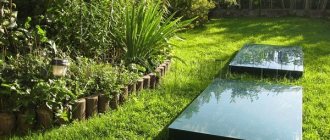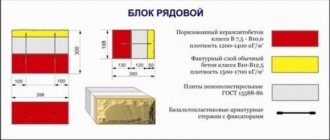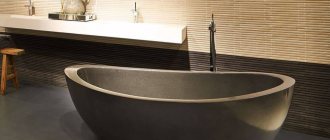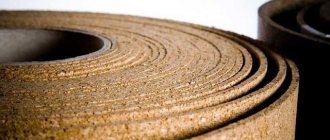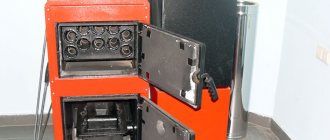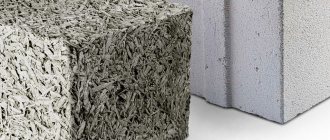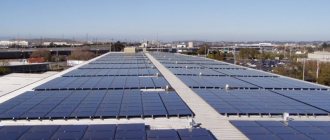A modern country house is as comfortable as a city apartment. It is equipped with a toilet, shower, washing machine and dishwasher. At the same time, centralized sewerage is most often absent. Its functions can be performed by a septic tank for a summer residence Tank, in which wastewater is accumulated and partially processed.
The treatment plant has gained popularity due to its simplicity of design, reliability and affordable cost. Are you unsure about your purchase? We invite you to familiarize yourself with the structure and operating principle of a septic tank, its pros and cons, as well as the rules for installation and maintenance.
The information presented will help you decide on the choice of modification of the Tank purifier and understand the feasibility of its installation. The material will also be useful to those who already use a storage septic tank at their dacha.
Installation design
Housing design
- Capacity. A cast polymer tank with no joint lines or seams. Compactness and stability are ensured by the rectangular shape. The ribbed walls act as lugs and facilitate the anchoring process.
- Hatch (one or two). Located at the top of the container. Sealant is used to secure the necks.
- The internal structure consists of several chambers (depending on the model), separated by partitions with pipes for water overflow. For example, in the Tank 2 septic tank, heavy impurities are separated in the receiving chamber, in the second, light impurities are processed by anaerobes, and in the third, a biofilter is installed for final water purification.
The polyethylene from which the body is made is an environmentally friendly and safe material, does not react with moisture and chemical compounds, and is not susceptible to erosion and oxidation. High activity of microorganisms does not affect the strength of the polymer. At the same time, cast polyethylene is affordable and makes the septic tank budget-friendly.
Among the disadvantages, the body material does not withstand external soil pressure well, so to prevent ruptures, installation requirements must be strictly followed.
Inside, the body consists of three sections. In the first, wastewater is collected and settled. Mechanical, organic and other large contaminants settle to the bottom under the influence of gravity.
The water flows by gravity into the second chamber, where microorganisms process the remaining organic compounds. The third section is equipped with a biofilter that separates residual impurities.
Biofilter functions
A biofilter is a container for multiplying and maintaining the activity of colonies of microorganisms. Floating bioload is necessary for the settlement of bacteria. Preference is given to anaerobic, settling on the bottom and walls of the container.
To increase the area of mechanical cleaning, plastic filtration products are poured into the septic tank. Polymers quickly float up and are localized near the inlet pipe. The material does not affect the activity of microbes and is chemically stable.
Another function of the biofilter is centrifugal separation. Water is supplied to the section at an angle, unwinds and is cleaned of heavy suspended matter. The principle of centrifugal separation is based on vortex microflows that are formed when liquid is drained.
VOC device
Tank treatment facilities have the following design:
- The body is made of polyethylene, which is manufactured using the casting principle. The thickness of its walls is 1.5 cm, in reinforced areas that undergo heavy loads - 1.7 cm. The design includes stiffening ribs.
- The body has inlet and outlet pipes and a neck, which is designed to pump out accumulated solid fecal matter. When pumping is not taking place, the hole is closed by a hatch. This protects the installation from debris, rainwater, and snow getting into it.
- Standard installations have 3 chambers, which are designed for different types of cleaning. All elements of the body can be expanded - the so-called block system is used. For example, even the largest septic tank, Tank Universal 4, can be expanded by expanding the chambers.
- Filtration of wastewater occurs in different ways - mechanical, chemical, biological - this is what ensures a high degree of purification.
- All installations, even the Tank mini septic tank, are equipped with a ventilation pipe and valve. The latter is triggered by gas pressure inside. There is an aeration pipe for a drip biofilter.
How does a septic tank work?
Which model is better for a summer residence?
The performance of the model is selected based on the constant load on the sewer system. The more people live in a house or country house, the larger the capacity should be. The number of infiltrators is also taken into account - containers without a bottom that further purify wastewater and discharge it into the soil.
The average volume of one is at least 400 liters. Their number depends on the performance of the septic tank. For example, two infiltrators must be connected to the Tank 2 septic tank, since the model’s capacity is 800 l/day.
When choosing, the characteristics of the soil, the total area of the site, the groundwater level, and the presence of problem areas in the soil are also taken into account. The price of a Tank septic tank with turnkey installation depends on the specific model and its performance.
Expert opinion
Albert Lyushin
Engineer-technologist with more than 15 years of experience.
Order installation of a septic tank
Advice! For areas with clayey, loamy soils and high groundwater, the Biotank-6 and Biotank-8 models are suitable. These energy-dependent (aerobic) devices purify wastewater up to 98%.
Operating principle of the autonomous sewage system “Tank”
- Wastewater flows through pipes by gravity into the primary settling tank, which is located in the first chamber of the septic tank. This is where the primary separation of water into fractions begins. The heaviest fraction precipitates, the light elements rise to the top. Clarified water remains in the central area.
- The clarified water, through the overflow system, flows by gravity into the next chamber of the “Tank” septic tank, where the subsequent purification process takes place - getting rid of small particles that are suspended in the water.
- At the next stage of purification, the water flows into a chamber that contains a biofilter with a floating load.
- Water flows from the outlet pipe, the purification level of which is 60-75%. This is considered a high level for autonomous sewers, but insufficient for discharging water into the ground. In order to be able to discharge purified water into the ground, the “Tank” septic tank is installed complete with an infiltrator. The infiltrator is a plastic container without a bottom. The internal volume of this container is 400 liters. Thanks to the infiltrator, the water undergoes further purification by passing through the soil filter.
Installation of a treatment system
Initially, a location on the site is selected to install a treatment plant. There should be no trees or shrubs nearby, the roots of which could damage the tank, or routes with constant vibration.
The recommended distance is 3-4 m. Afterwards, a deep pit is dug using an excavator or other special equipment. The size of the pit should be 60 centimeters larger on all sides than the dimensions of the septic tank Tank.
Next are the following steps:
- creating a sand cushion 35 cm high to level the bottom;
- installation of a septic tank with further leveling;
- connecting pipes, filling sections with water;
- backfilling the well contour with a mixture of cement and sand (1:5).
A layer of insulation is laid on top, which is covered with earth.
The first launch is carried out by specialists: the septic tank is filled with clean water to 65-70%, the tightness of the connection with the sewer is checked by starting it.
In two weeks, the water will be completely replaced by wastewater. If sewer pipes are deeper than the standard height of the equipment, it is recommended to use Eurotank Long models with an extended neck.
How the work process works
To make the right choice, you need to know how the Tank functions.
- household wastewater flows through a pipeline into the first tank, in which the fermentation process and splitting of the flow into organics and inorganics are organized. The heavy suspension settles at the bottom of the chamber;
- conditionally purified water flows into the second compartment, in which the process of splitting and separation of solid elements continues;
- final purification occurs in a biological filter. At the exit from the station there is water with a 75% degree of purification;
Additional treatment using an infiltrator
For higher purification, the flows must undergo additional purification in the ground using an infiltrator, which is complemented by the Tank station.
To install the infiltrator, it is necessary to dig a pit, the bottom of which must be covered with spunbond. You can use a plastic mesh. Then a crushed stone cushion is installed.
The wastewater deposited using a septic tank is further purified in an infiltrator by passing through crushed stone.
When using such a device, the degree of purification reaches a maximum of one hundred percent. Absolutely purified liquid enters the soil.
In the case of increased discharges of sewage water, the liquid may remain for some time on the surface of the crushed stone, gradually being absorbed into the soil.
This device is very convenient for sudden visits to the country. On weekends, the load on the infiltrator becomes maximum; over time, everything will gradually seep into the ground.
For large industrial volumes, it is recommended to install several after-treatment units.
Post-treatment using drainage pipes
The discharge of wastewater after purification in a septic tank can be carried out using a drainage pipe. Installation can only be done in normal soil. An area of about 30 square meters should be cleared for equipment. In this regard, the installation can only be built on plots with large land areas.
Well treatment device
The equipment can only be installed if the groundwater level is low. Filtration in a well is quite easy to do and has a low cost. The runoff masses go deep into the ground after purification.
Advantages of septic tanks
- Reliability. The reservoir does not wear out and is not affected by chemical, mechanical, or microbiological influences. Service life reaches 30 years or more.
- Strength. The housing can withstand soil pressure if all installation requirements are met.
- Easy to maintain. The operating principle and structure of the septic tank Tank do not require constant repair or maintenance. The user only needs to call a vacuum cleaner once a year for cleaning.
- Availability. These models are among the most affordable. To find out how much it costs to install a turnkey septic tank, it is enough to determine the required capacity and the number of sections.
- Productivity increase. Connecting additional modules is possible even to a system that is already functioning.
- Quality of cleaning. Sewage is purified from mineral, organic and other impurities by 50-98%.
- Easy to install. The body is compact, has a convenient shape and is light weight due to the use of polymers.
Tank 3 is considered one of the most popular in the ranking of budget septic tanks for a summer residence without pumping. The disadvantages of all installations of this type include the need for additional purification of water before draining into the ground, and the dependence of most models on electricity.
Main parts
In dacha and suburban areas, a sewerage tank with the following components is most often installed:
- A body divided into several sections by partitions with an overflow. The number of sections is determined by the needs of the family.
- Biofilter. It contains anaerobic bacteria responsible for processing organic waste.
- Inlet and outlet pipe.
- Neck with lid.
An autonomous sewage tank with one body is suitable for a family of 5-6 people and can process up to 1200 liters of liquid per day.
Features of operation and maintenance
Regardless of the volume and capacity, it is prohibited to dump diapers, personal hygiene products, plastic bags and plastic items, rags, and food waste into the septic tank Tank 1, 2, 3 and other models. Not only are they not processed by the septic tank, but they can also cause damage to the hull.
To avoid compaction and compaction of the sediment and impurities accumulated in the septic tank, the manufacturer recommends pumping it out once a year with a sewer truck, as well as cleaning the air compressor and changing the biological membrane. After emptying the chambers of the septic tank, it is necessary to fill it with water to resume the normal operating cycle.
Expert opinion
Albert Lyushin
Engineer-technologist with more than 15 years of experience.
Order installation of a septic tank
Volatile structures can operate autonomously for another 24 hours during a power outage. At the same time, the level of water purification does not exceed 80%. If power outages occur constantly, it is better to give preference to non-volatile anaerobic options or purchase a generator.
About the manufacturer
is one of the largest Russian manufacturers of septic tanks and other plastic products.
The vast experience of the company’s employees and partners allows us to manufacture, deliver and install treatment plants throughout the country in the shortest possible time. Thanks to the high quality of manufacturing and installation, the availability of warranty and post-warranty service, Triton Plastic customers do not have to worry about any problems regarding wastewater disposal and treatment.
Conservation of septic tanks Tank and Biotank
Before the onset of cold weather, it is necessary to preserve the installation if it will not be used during this period.
For septic tank Tank 2, 3 and other models, the conservation process consists of the following steps:
- disconnecting equipment from power supply;
- pumping out liquid from chambers;
- washing of nozzles and sections;
- filling the body 2/3 with clean water with the addition of weights with sand to compensate for soil pressure;
- removing the compressor and storing it separately in a warm place;
- insulation of the septic tank lid (if not done before).
Before further use after winter, you need to pump out the water again and remove the weights, connect the compressor and start the sewer system.
To preserve the Biotank, the collection and settling compartments are cleaned (the aerator and biofilter are not washed), the tank is filled 2/3 with water without a load.
Buy an autonomous sewerage system “Tank” in installments.
Now it is possible to purchase “tanks” in installments, thanks to our affiliate program. Installment plans for septic tanks occur in the following order:
- We enter into an installment plan agreement (civil contract with us.
- We already conclude an agreement with the bank ourselves, so you will have 2 agreements in your hands.
- we divide the cost of the septic tank into several feasible payments,
- You can choose installments from 4 to 24 months, based on your situation.
- down payment 10-20%
- Our managers will help you calculate the payment amount,
- no interest on installment agreement


